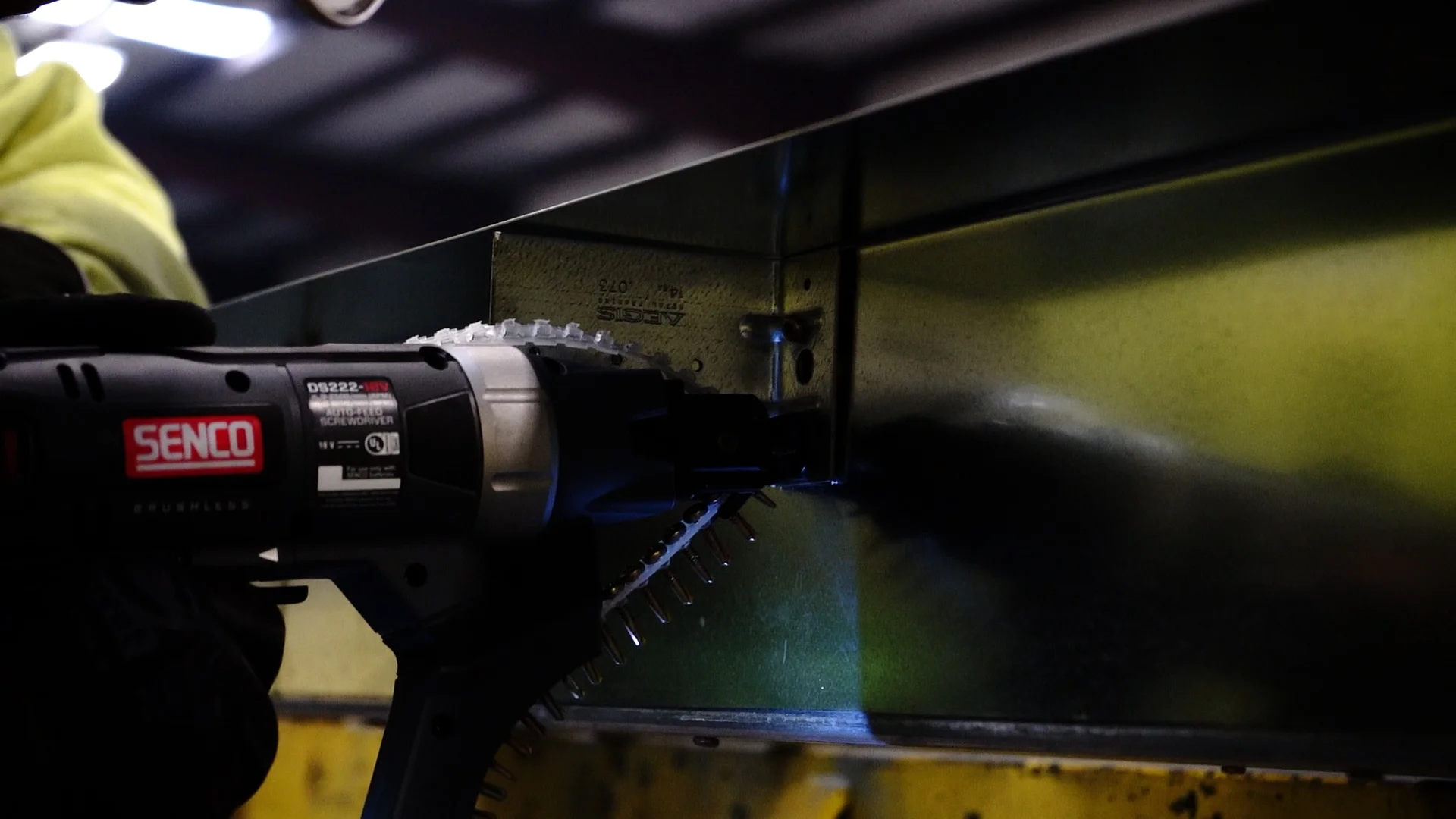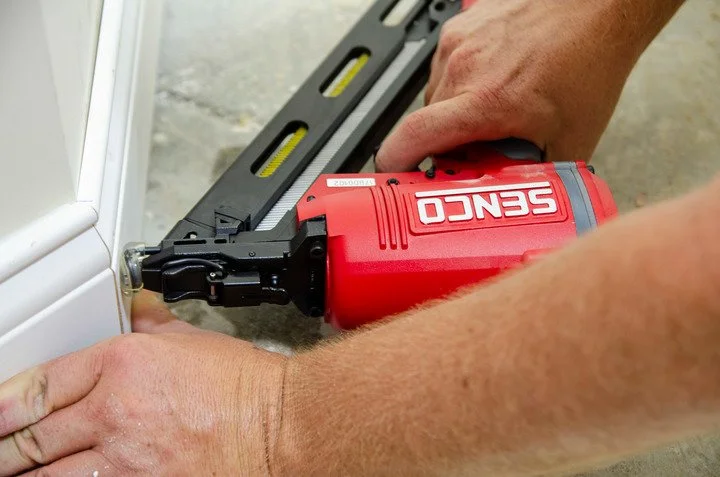Frequently Asked Questions
Most small portables will suffice. For instance; a very small 1HP portable (delivering 2.0 CFM – cubic feet of air per minute) will allow you to operate SENCO’s largest nailing tool at about 15 nail drives per minute. The same compressor will run a medium-size finishing nailer at about 30 nail drives per minute, and will run a small brad nailer at over 70 drives per minute.
SENCO tools take a “gulp” of compressed air for each fastener drive. Big tools take a bigger gulp; smaller tools use less of a gulp. The technical term for this gulp is “air consumption per cycle”. If you divide the air consumption per cycle into the CFM of a given air compressor you will determine the possible drives per minute. This should give you a clear picture if the compressor is able to properly supply the tool you are planning to use.
Few people, maybe some pros, will operate SENCO tools at super high speeds. Most people will buy the easy-to-carry portables for the convenience of being able to take the compressor to the job site. The 30-lb. portables tend to deliver about 2.0 CFM; the 50-lb. units usually deliver about 4.0 CFM.
This information can be found within the operator’s manual included with your tool or on our website under the specs section of the individual tool’s product page.
- F&T 80 Framers 110-120
- Framing – 100-130 PSI
- Finish 60-120 PSI
- Brad Nailer 60 – 100 PSI
- Roofing 90-100 PSI
You should always follow the lubricating instruction listed in the operating instructions of the manual for your tool. Some tools need to be lubricated and some are oil-less.
To properly load:
- Turn the tool up-side-down – aiming upward.
- Slide open the track (magazine rail – the moving part).
- Set the staples into the housing channel right behind the nose.
- Slide the rail to the closed position.
For roofing nails, most shingle manufacturers recommend using four nails per shingle. Using this measurement will average to 320 nails per 100 square feet. In high intensity areas (such as areas susceptible to strong winds) use 5 nails per shingle, which will average about 480 per 100 sq ft.
A debate that is seemingly as old as the industry that it presides, whether you prefer to use nails over staples may be dependent on personal preference or what you were taught by your peers. Generally, staples are regarded as having greater holding potential than nails. However, nails are also less visible and are easier to remove with less damage. Depending upon application, the choice in fastener may not be all based in personal preference. Certain building codes mandate that a particular fastener be used for specific applications. As with any project, ensure that your chosen fastener is correct for the application it is being used.
SENCO® DOES NOT RECOMMEND THE USE OF EXTENSION CORDS as this can create power loss and overheating of the motor. Use of an additional air hose is recommended rather than an extension cord. If use of an extension cord is unavoidable, it should be plugged into a GFCI found in circuit boxes or protected receptacles. When using an extension cord, observe the following:
Cable Length Wire Gauge
- Up to 25 feet 12 AWG
- Up to 100 feet 10 AWG
- Up to 150 feet 8 AWG
- Up to 250 feet 6 AWG
Use only 3-blade extension cords that have 3-blade grounding-type plugs and 3-slot cord connectors that will accept the plug from the product. Use only extension cords having an electrical rating not less than the rating of the product. Do not use damaged extension cords. Examine extension cord before using and replace if damaged. Do not abuse extension cord and do not yank on any cord to disconnect. Keep cord away from heat and sharp edges. Always shut off the air compressor switch before removing the plug from the receptacle.
We have a great blog post that addresses all of the pros and cons of both types of self-lubricating tools here
In short, traditional oilless nail guns are manufactured with a base layer of grease that lubricates the tool internally, without the need for action from the user. Over a long period of time, the grease may dry up or become ineffective. The nailer can be disassembled, relubricated, and reassembled. Essentially, oilless tools trade constant, daily maintenance for a single round of more in-depth maintenance every 5 to 10 years.
SENCO’s NeverLube® nail guns are truly oil-free, there is no grease applied to these tools during manufacturing. Instead, it uses proprietary components made from a unique graphite composite that require no lubrication at all. These wear resistant parts keep your tool firing for years without daily oiling. Apart from elimination of maintenance, NeverLube® tools operate exactly the same as other types of nailers, and last as long.
Nails are often coated to protect them from the elements and in turn increases their effectiveness and their lifespan.
- Hot-Dipped Galvanized – These nails are dipped and coated in molten zinc, giving them a matte grey appearance. The zinc coating allows for significant corrosion resistance. That’s why these nails are most often used in applications where these nails would be exposed to the elements. In addition, galvanized nails are recommended for pressure-treated wood because copper is part of the pressure treatment. Due to galvanic action, the copper would corrode metal nails without the galvanized, zinc coating. Senco’s Hot Dip Galvanization is Class D is per ASTM A153.
- Galvanized – Called Electro Galvanization, this is regular galvanization per ASTM 641.
- Bright Basic – Bright Basic nails are non-coated nails that are best suited for indoor use. This is because there is NO outer protective covering on the fastener such as there is in the Hot Dip and Electro Galvanization processes.
- 304 Stainless Steel – No coating at all, most resistant to corrosion. Most widely used in coastal areas where salt can corrode other types of fasteners.
- Sencote – SENCO’s Sencote coating is a vinyl coating that serves two purposes. First, the vinyl makes the nail easier to drive by reducing friction. When driven, the vinyl melts. After cooling, the vinyl adheres the nail to the wood, which makes it harder to remove.
- Aluminum – Aluminum coil nails are rust resistant nails used primarily in aluminum siding and screening. These nails are naturally rust resistant due to their material, and therefore do not need any type of coating.
The two Fusion framing nailers are capable of firing up to 600 fasteners per full charge on the 3.0Ah battery. The Fusion finish and trim line of tools are capable of firing between up to 550 and 650 fasteners per full charge on the 1.5Ah battery. It will take about 30 minutes to charge the battery 80% and a full hour to charge the battery to 100%.
The cordless DuraSpin™ line of tools are capable of over 2000 – 1 ¼” drywall to wood screws per full charge of the 3.0 AH battery. The batteries quick charge feature charges the battery to 80% in 20 minutes and the battery will reach full charge after roughly an hour.
The primary thing to consider when selecting a drive bit is the material that you will be driving into. The denser the material, the more torque is needed to drive the fastener flush against the work surface. Inversely, the less dense materials require less torque but higher speeds to efficiently drive fasteners into drywall.
- The Philips drive type is a tried and tested drive type that is one of the most popular screw drive type in several industries. The Philips head was specifically designed to slip out or “cam out” of from the recess once a certain amount of torque has been reached to prevent overtightening. This makes the Philips drive type more ideal for high RPM applications like drywall or subfloor.
- Like the Philips, the square head recess is known for being a well-regarded drive type, and its use is very prevalent in the Canadian market. The square drive, also known as the Robinson drive type, uses friction to hold itself in place during the driving process. The design of the square drive retains tension more efficiently than the Philips, making it ideal for denser materials.
- Dense materials require more complex drive types. The REX drive type has more surface contact, resulting in better bit engagement with the screw through dense materials and higher levels of torque. (see “What a rex drive?” for more info)
The REX drive is a hexalobular (six-sided) drive type that is similar to a T20 or T25 torx drive. This particular drive type is most suited towards high-torque applications into dense materials. The structure of the REX drive results in less wear extending the overall life of the bit.
It all depends on the amount of use. A tool used every day by a pro will probably need a rebuild every 1-2 years, while tool being used once per week may go 5-10 years before needing any kind of service.
Ironically, oil-type tools will last longer if regularly used. Longer storage with no operation will lead to a dry rotting of certain o-rings. It’s best to get them out, oil them up, and cycle the tool to keep the rings lubricated.
Some SENCO tools are a no-oil design and can store for longer time periods with no concern.
When rebuilds are necessary, you can choose to hire a servicing dealer, or do the job yourself with the handy o-ring and rebuild kits offered by SENCO for most tool models. SENCO leads the industry in making self-service easy to do.
SENCO tools are professional-grade. Compared to discount brands they last longer, and they work longer before any service becomes necessary.

